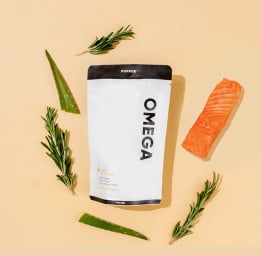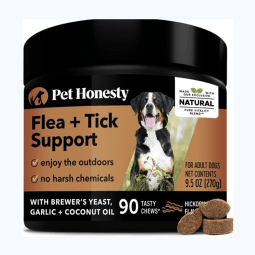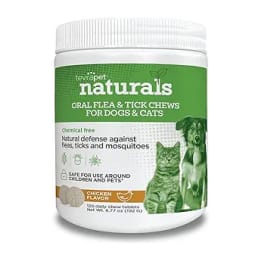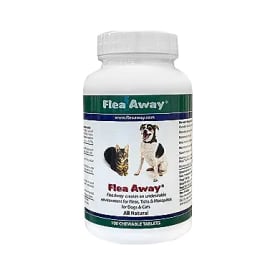4 Best Natural Flea Treatment For Dogs

Advertorial: This content is produced by a third-party advertiser. Statements are not fact checked by a medical professional.
- Best omega-3 supplement: Pupper Omega
- Best flavor: PetHonesty Flea & Tick Defense
- Best for fleas and ticks: TevraPet Naturals Oral Flea & Tick Supplement
- Best chewable tablet: Flea Away Flea & Tick Oral Treatment
Sometimes your dog may fall prey to fleas, despite your best preventative efforts. Thankfully, there are plenty of products you can use to rid your dog of the parasites, even if you favor natural alternatives.
Natural flea treatments for dogs utilize plant-based ingredients to repel, deter, and eliminate fleas from a dog's coat and environment.
You may find natural flea treatments appealing if you try to limit your use of products with synthetic chemicals in general, or if you’re concerned about the possible side effects of flea products specifically. While the FDA has deemed that flea products in the isoxazoline class (which includes many common flea medicines) are safe for most dogs, the agency has also warned about possible side effects1. These can include muscle tremors, ataxia (loss of muscle control), and seizures.
Whatever your motivations for choosing a natural flea treatment, you have plenty of options. These treatments come in various formats, including sprays, shampoos, topical treatments, supplements, collars, and combs. The supplements in particular often contain ingredients like garlic, coconut oil, and brewer's yeast due to their potential properties in repelling fleas.
However, it's important to note that the effectiveness of these ingredients in preventing or treating flea infestations can vary, and scientific evidence supporting their efficacy is limited.
Garlic contains compounds that are believed to have natural insect-repellent properties2. However, there is a significant debate among veterinarians and experts regarding the safety of garlic for dogs. In large amounts, garlic can be toxic to dogs, damaging their red blood cells and causing anemia.
Coconut oil has gained popularity for its potential health benefits, including its potential ability to repel fleas and ticks. Coconut oil contains lauric acid, which some claim has natural insect-repellent properties3. While coconut oil is safe for dogs in moderation and can contribute to skin and coat health, its effectiveness as a sole anti-flea treatment is not well-established.
Finally, brewer's yeast is often included in natural flea supplements due to its content of B vitamins, particularly thiamine (vitamin B1). Some believe that the scent produced when a dog consumes brewer's yeast makes them less attractive to fleas4. However, scientific evidence supporting this claim is lacking. Brewer's yeast is generally considered safe for dogs, but its flea-repelling properties may not be highly effective on their own.
The number of pet care products available can make choosing the most suitable option overwhelming. To assist you in finding the best natural flea and tick treatments, we’re sharing our top picks.
What to look for in the best natural flea treatment for dogs
When searching for the best natural flea treatment for dogs, there are several essential factors to consider. Here are some key elements to look for:
- Natural ingredients: Double check that the ingredient list includes plant-based ingredients that are known for their flea-repelling properties. As mentioned, garlic, coconut oil, and brewer’s yeast are common choices.
- Multiple pest repellent: Some natural flea treatments also repel other pests like ticks, mosquitoes, and flies. If you live in an area with multiple pest threats, consider a product that offers broader protection.
- Reviews: Read customer reviews to gain insight from other pet owners. Positive feedback can indicate the product's reliability and effectiveness.
- Easy of application: Choose a product that is easy to apply, whether it's in the form of a topical solution, collar, or spray. We focused on supplements here, since they’re one of the easiest products to incorporate into your daily routine.
Remember that natural flea treatments may not be as potent as prescription flea medicine, so they may not be sufficient in all cases. If you notice a severe infestation or persistent flea problems, consult your veterinarian for further advice.
Pros:
- Discounted subscription option
- May improve quality of fur
Cons:
- Does not contain ingredients to repel fleas
Recommended dose:
10 to 20 mg of EPA and DHA per pound of body weightKey ingredients:
Salmon oilEPADHAQuantity:
30 chewsSubscription Discount:
YesPupper’s Omega is an omega-3 supplement that contains fish oil, EPA, and DHA, which are all types of omega-3 fatty acids. These soft chews are a good option promote skin comfort after a flea bite reaction.. While this supplement does not prevent fleas, it's still a helpful way to promote your pup's overall skin and heart health.*
Pros:
- Made in the U.S.
- Contain B vitamins
Cons:
- Not meant for dogs less than one year old
Recommended dose:
1 chew per 25 lbsKey ingredients:
Coconut oilGarlic powderFlaxseedQuantity:
90 chewsSubscription Discount:
YesThese bacon-flavored chews contain garlic, coconut oil, and brewer’s yeast to repel fleas, ticks, mosquitos, and other pests, and many customer reviewers find that the combo is effective. “I’ve been given these to my pups for a few months now and I haven’t had a single tick (or flea) on them so far this summer!” one person wrote. “They spend a lot of time outside as well. They LOVE them too! Highly recommend.”
Advertisement
Pros:
- Contain vitamin complex
- Protect against ticks and mosquitos
Cons:
- May not reach full strength for 30 days
Recommended dose:
1 chew per 25 lbsKey ingredients:
GarlicVitamin ENiacinVitamin B1Quantity:
120 chewsSubscription Discount:
YesTevraPet Naturals Oral Flea & Tick Supplement contains ingredients like garlic and brewer’s yeast to provide natural defense against fleas, ticks, and mosquitoes. They’re intended to mask the smell of carbon dioxide, which may otherwise attract pests to your pet. The supplements also contain vitamins B1, B6, B12, and E, to round out your pet’s diet. The chicken-flavored chews are meant for dogs or cats that need protection from pests.
Pros:
- Suitable for both cats and dogs
- Liver flavor
Cons:
- May take around 30 days to start taking effect
Recommended dose:
1 chew per 50 lbsKey ingredients:
Vitamin ENiacinThiamineVitamin B6FolateVitamin B12CalciumBrewer's yeastQuantity:
100 chewsSubscription Discount:
YesThis chewable tablet called Flea Away is meant for dogs and cats of all ages. It targets fleas with brewer’s yeast and thiamine, while clearing up sores and scabs that result from bites. That said, it may not be the best option for treating an existing issue as it can take around 30 days of consecutive use to start taking effect, according to the brand. Dog owners that have stuck with it have been impressed. “We live in very high tick area,” one customer reviewer wrote. “Our dogs have been on this for three months now. No fleas. No ticks. Very pleased!!!”
Advertisement
Takeaway
You can choose to take a more natural route when protecting your dog against fleas and other pests. These solutions can protect your pet from the discomfort and health risks associated with fleas, while giving you peace of mind if you’re concerned about the potential hazards of traditional flea repellents.
*These statements have not been evaluated by the Food and Drug Administration. These products are not intended to diagnose, treat, cure, or prevent any disease.
Meet The Experts
4 Sources
- https://www.fda.gov/animal-veterinary/animal-health-literacy/fact-sheet-pet-owners-and-veterinarians-about-potential-adverse-events-associated-isoxazoline-flea
- https://www.ncbi.nlm.nih.gov/pmc/articles/PMC5397855/
- https://www.ncbi.nlm.nih.gov/pmc/articles/PMC6145915/
- https://pubmed.ncbi.nlm.nih.gov/32009117/



